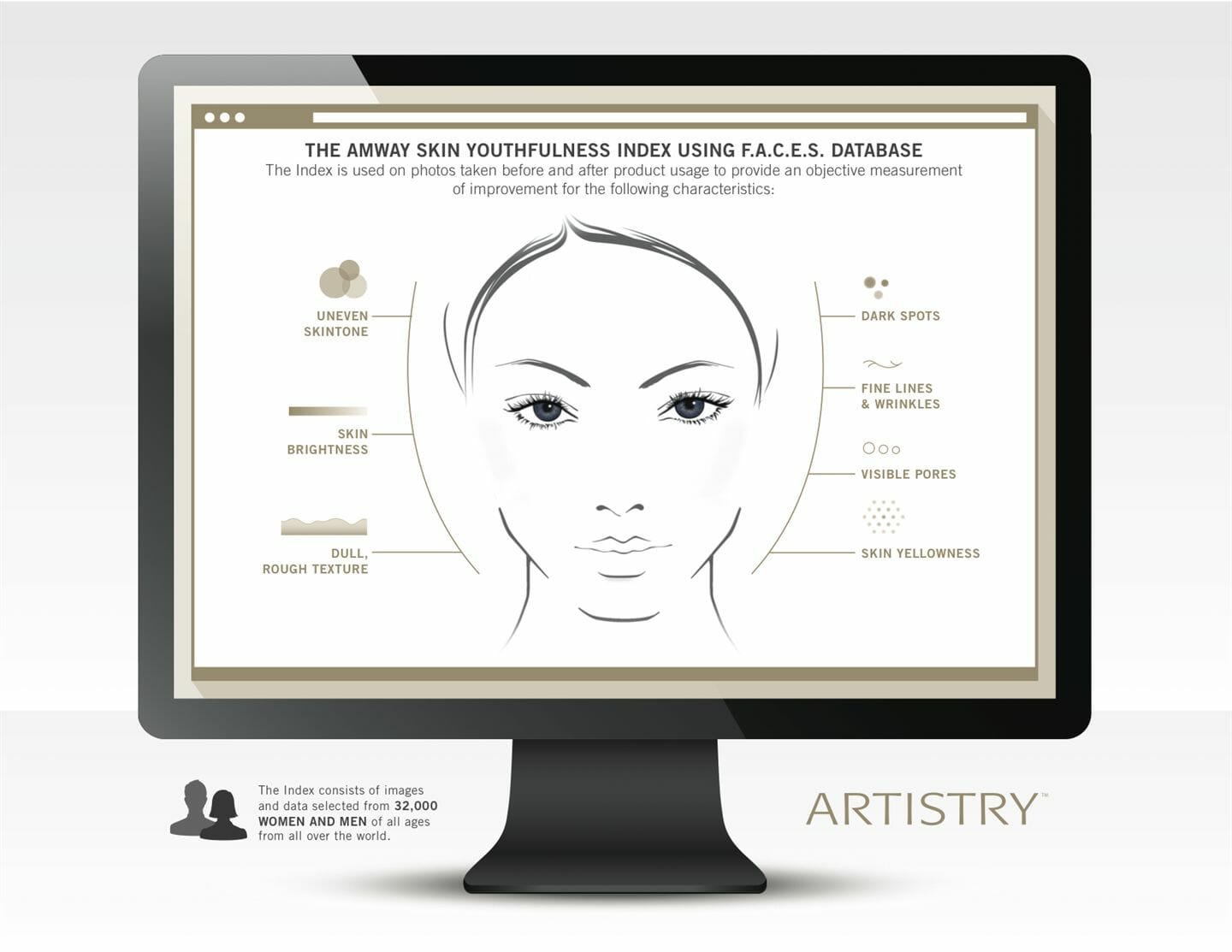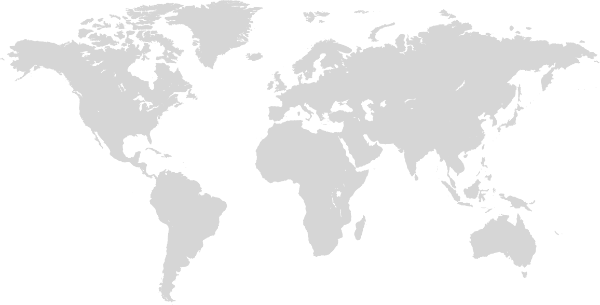
What if you could take pictures of your face with special technology that helps visualize what’s happening at the skin’s surface? We’re talking about seeing where dark spots and wrinkles are beginning to form. Where sun damage has collected.
Imagine what you could learn about how to care for your skin if you could see what’s already happening that isn’t always visible to your naked eye.
Amway can do that.
In fact, scientists in the Amway beauty labs have looked that closely at the faces of more than 32,000 people around the world, using a camera and sophisticated facial-recognition software tailored for Amway. The tool is called F.A.C.E.S., or Facial Analysis Computer Evaluation System.
“The sheer number of subjects and quality of imaging and analysis in our global database is unique among cosmetic companies.” – Paul Seehra, Amway director of global technology discovery
Amway has used F.A.C.E.S. since 2009 to collect and analyze photos and data on subjects in 12 countries in the Americas, Greater China, Asia Pacific, southeast Asia and Europe. The photos include women and men of all ages, ethnicities and skin types, who also answered questions on how they perceive their facial skin, their skin concerns and the amount of sun exposure they’ve gotten on their faces over the last 10 years.
The images and data are aggregated into one huge proprietary database that has aided Amway scientists and clinical researchers – even some of the Artistry Scientific Advisory Board – in understanding skin, how it ages, and the efficacy of skin care products.
“The sheer number of subjects and quality of imaging and analysis in our global database is unique among cosmetic companies,” said Paul Seehra, Amway director of global technology discovery. “For us as skin care formulators, the scientific advantage of having this very large database from around the world, with diversity in age, gender and ethnicity, is undeniable.
“Our biggest market for Artistry™ skin care is Asian women,” Seehra said. “How do we develop skin care products especially for Japanese women, Chinese women, Thai women, from here in Ada, Michigan? How do we determine how their needs differ from our customers in Europe, India and the Americas? We tap into the data and images in F.A.C.E.S.”
That F.A.C.E.S. has helped significantly elevate the level of scientific excellence for the Artistry™ premium beauty brand also is undeniable. In fact, F.A.C.E.S. played a key part in three Amway research posters that Amway scientists presented at the 23rd World Congress of Dermatology in June 2015.
Held every four years, the Congress is the world’s oldest continuous international dermatology conference, dating back to 1889. The Congress draws about 12,000 physicians, medical professionals, exhibitors, members and journalists. Amway scientists also presented two posters at a concurrent conference, the International Society for Biophysics and Imaging of the Skin.
“The information you can extract from the F.A.C.E.S. database is – by orders of magnitude – of a higher level than you can get with even the best imaging system. I think Amway wouldn’t be where it is now with the new generation of Artistry™ products if they didn’t have the F.A.C.E.S. database.” – Patricia Ogilvie, MD, Artistry™ Scientific Advisory Board member
As a member of the Artistry™ Scientific Advisory Board, Patricia Ogilvie, M.D., an aesthetic dermatologist in private practice and research in Munich, Germany enjoys unique access to research tools in the Amway beauty labs. She also shares her expertise and experience to help guide development of Artistry™ beauty products and collaborates with Amway scientists.
“The analysis software is proprietary to Amway, so all the information we capture and the way we calculate it is absolutely unique and nobody else has access to it,” she said.
“The information you can extract from the F.A.C.E.S. database is – by orders of magnitude – of a higher level than you can get with even the best imaging system. I think Amway would not be where it is now with the new generation of Artistry™ products if they didn’t have the F.A.C.E.S. database,” Ogilvie said.
“What’s really special,” Seehra added, “is that we’ve taken attributes that women have told us are important to them, and things that happen to their skin as they age that they don’t like. For example, Asian women tell us they prize brightness and translucency, which they often lose as they age.
“Historically, we would evaluate improvement from product usage by asking subjects to look in the mirror every day and tell us if they think their skin looks brighter. Or we would rely on an expert grader, someone trained to score the skin on change after product usage.”
The problem, according to Seehra, is that those are subjective visual evaluations, dependent on a reference that varies in each person’s mind.
So Amway Research Scientist Di Qu pulled F.A.C.E.S. data and images for seven of the most important visible aging attributes and developed a mathematical formula called the Skin Youthfulness Index. The index can be used on photos taken before and after product use to provide an objective measure of improvement.
“Now we’ve got a ‘super grader’ that can grade thousands of photos the exact same way every time,” said Seehra. “It takes the subjectivity out of the analysis and gives us a much better assessment of how products are performing, how signs of aging are developing, and so forth. It’s a reliable, objective analysis – scientifically sound because all the measures are validated as reproducible and accurate.”
“[F.A.C.E.S. is] a reliable, objective analysis – scientifically sound because all the measures are validated as reproducible and accurate.” – Paul Seehra
Much of cosmetics research relies on subjective consumer perception for benefits such as more even skin tone. That’s valid if the consumer is satisfied, said Seehra.
But F.A.C.E.S. definitely raises the bar for scientific research by cosmetic manufacturers, said Soyun Cho, M.D., Ph.D., professor of dermatology at Seoul National University College of Medicine.
Cho also is a member of the Artistry Scientific Advisory Board, who shares expertise and experience on Artistry™ beauty products and collaborates with Amway scientists.
“Amway’s high scientific rigor is THE major reason I decided to join the Scientific Advisory Board.” – Soyun Cho, MD, Artistry™ Scientific Advisory Board member
“You can test a product on 30 women and quote their subjective impression of the product or use celebrity marketing to sell a product, but Amway does not rely on only this,” Cho said.
“Amway has capable, passionate and dedicated scientists who can analyze numerous photo images from the F.A.C.E.S. database to elucidate what’s happening in the skin.”
F.A.C.E.S. and Qu’s skin index also have application in product formulation. Seehra explains that evaluating different key ingredients, different levels of ingredients or different formula bases requires being able to quantify differences, especially when trying to analyze really small changes.
“We can do that with F.A.C.E.S. data,” he said. “We might not make a claim out of it, but it helps us develop the best product.”
“The kind of deep knowledge we have about our specific customers is invaluable. It’s a solid scientific grounding for our beauty lines.” – Paul Seehra
The quantification itself is giant leap. But the system’s special photographic capabilities, like “ghost” imaging with accurate photographic alignment and precise lighting effects, enable Amway scientists to use before-and-after photos to finely correlate the objective and subjective measurements – and discover how much of a quantifiable change must happen before a person can see it.
Before-and-after photos are so important, and the F.A.C.E.S. photographic system is so precise, that Amway Research Scientist Di Qu worked with a vendor partner to develop a patented* technique that automates color correction to ensure the color is always true and to eliminate irregularities from aging lights or the subject’s distance from the camera.
Even as the earlier F.A.C.E.S. components are gradually being phased out for newer components that supply data in a slightly different way, Amway scientists know the F.A.C.E.S. database still holds tremendous potential.
“The kind of deep knowledge we have about our specific customers is invaluable,” Seehra said. “It’s a solid scientific grounding for our beauty lines.”
Cho said, “Amway’s high scientific rigor is THE major reason I decided to join the Scientific Advisory Board. Amway is a company that respects and honors researchers’ and physicians’ new ideas and inputs. I am always happy to witness talented Amway scientists working so hard to develop better products, being true to the company’s mission.”





